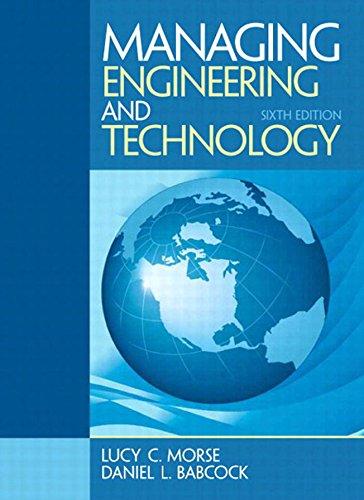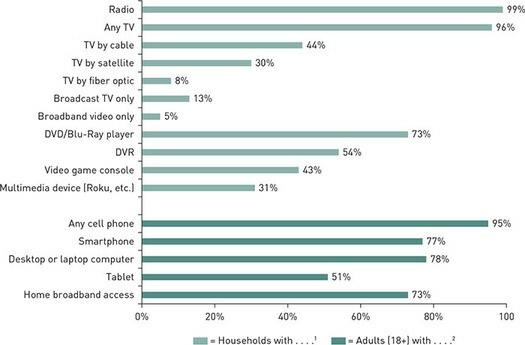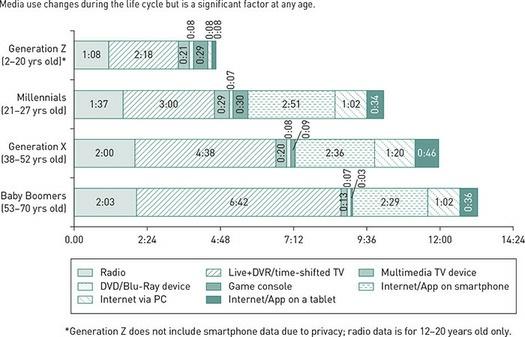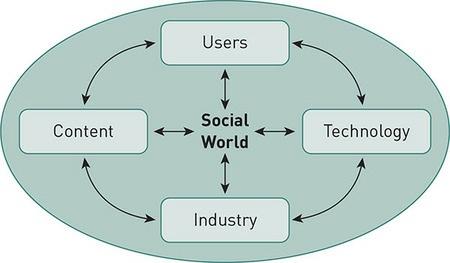Media/Society: Technology, Industries, Content, and Users 6th Edition, (Ebook PDF)
Visit to download the full and correct content document: https://ebookmass.com/product/media-society-technology-industries-content-and-use rs-6th-edition-ebook-pdf/

More products digital (pdf, epub, mobi) instant download maybe you interests ...

Managing Engineering and Technology 6th Edition, (Ebook PDF)
https://ebookmass.com/product/managing-engineering-andtechnology-6th-edition-ebook-pdf/

Media Now: Understanding Media, Culture, and Technology 10th Edition Joseph Straubhaar
https://ebookmass.com/product/media-now-understanding-mediaculture-and-technology-10th-edition-joseph-straubhaar/

Media Now: Understanding Media, Culture, and Technology 10th Edition Joseph Straubhaar
https://ebookmass.com/product/media-now-understanding-mediaculture-and-technology-10th-edition-joseph-straubhaar-2/

Bossa Mundo: Brazilian Music in Transnational Media
Industries K.E. Goldschmitt
https://ebookmass.com/product/bossa-mundo-brazilian-music-intransnational-media-industries-k-e-goldschmitt/

(eBook PDF) Media and Communication in Canada Networks, Culture, Technology, Audience, Ninth 9th Edition
https://ebookmass.com/product/ebook-pdf-media-and-communicationin-canada-networks-culture-technology-audience-ninth-9th-edition/

Mass Communication: Living in a Media World 6th Edition, (Ebook PDF)
https://ebookmass.com/product/mass-communication-living-in-amedia-world-6th-edition-ebook-pdf/

Media Logic(s) Revisited: Modelling the Interplay between Media Institutions, Media Technology and Societal Change 1st Edition Caja Thimm
https://ebookmass.com/product/media-logics-revisited-modellingthe-interplay-between-media-institutions-media-technology-andsocietal-change-1st-edition-caja-thimm/

Media Today: Mass Communication in a Converging World 6th Edition, (Ebook PDF)
https://ebookmass.com/product/media-today-mass-communication-ina-converging-world-6th-edition-ebook-pdf/

Ethics in Information Technology 6th Edition Reynolds
https://ebookmass.com/product/ethics-in-informationtechnology-6th-edition-reynolds/

DetailedContents
Preface
Acknowledgments
PartIINTRODUCTION
Chapter1Media/SocietyinaDigitalWorld
TheImportanceofMedia
ModelsofCommunicationMedia
Interpersonaland“Mass”Communication
VariableBoundariesandActiveUsers
CommunicationToday:AFirstLook
ASociologyofMedia
TheSociologicalPerspective
StructuralConstraintandHumanAgency
Structure
Agency
StructureandAgencyintheMedia
RelationshipsbetweentheMediaandOtherSocialInstitutions
RelationshipswithintheMediaIndustry
RelationshipsbetweentheMediaandthePublic
AModelofMediaandtheSocialWorld
ApplyingtheModel:CivilRightsinTwoMediaEras
Mid-20th-CenturyCivilRightsMovement
BlackLivesMatter
Conclusion
DiscussionQuestions
PartIITECHNOLOGY
Chapter2TheEvolutionofMediaTechnology
TheHistoryofMediaTechnology
TechnologicalDeterminismandSocialConstructionism
TechnologicalDeterminism
Media’sMateriality
“AutonomousTechnology”and“TechnologicalMomentum”
MediumTheory
McLuhan’sOptimism
Postman’sPessimism
SocialConstructionism
FromPrinttotheInternet
ThePrintMedium
TheTelegraph
TheTelephone
SoundRecording
FilmandVideo
RadioBroadcasting
Television
TelevisionandDailyLife
CableTelevision
TheInternet
CreatingtheInternet
TheInternetGrowsUp
SomeCharacteristicsoftheInternetEra
Conclusion
DiscussionQuestions
PartIIIINDUSTRY
Chapter3TheEconomicsoftheMediaIndustry
MediaCompaniesintheInternetEra
Products
Platforms
Pipes
ChangingPatternsofOwnership
ConcentrationofOwnership
Products
Platforms
Pipes
ConglomerationandIntegration
StrategyinaNewMediaEconomy
ThePowerofPlatforms:FacebookandGoogleasNewMediaGiants Users
MediaContent
Advertising
Telecommunications
ConsequencesofConglomerationandIntegration
IntegrationandSelf-Promotion
TheImpactofConglomeration
TheEffectsofConcentration
MediaControlandPoliticalPower
MediaOwnershipandContentDiversity
MassMediaforProfit
Prime-TimeProfits
CheaperProgramsforSmallerAudiences
ControllingContentandDistribution
ProfitandtheNewsMedia
TheImpactofAdvertising
TheAdvertising-ContentConnection
AdvertisingandthePressinthe19thCentury
TheBritishPress
TheUS Press
AdvertisingandtheContemporaryNewsMedia
Conclusion
DiscussionQuestions
Chapter4PoliticalInfluenceonMedia
MediaandDemocracy
FreeSpeechtoFreeMarkets:TheEvolutionofUS RegulatoryPolicy
RegulateorDeregulate?
TheFCC’sVariableRole
RegulationinInternationalPerspective
RegulationinWesternDemocracies
RegulationinDevelopingNations
CompetingInterestsandtheRegulationDebate
IndustryInfluence:ElectionsandLobbying
CitizenAction:TheCaseofLow-PowerRadio
LeftandRight:DiversityversusPropertyRights
RegulatingOwnership
MediaOutlets
CopyrightandIntellectualProperty
RegulatingContent
Accuracy:Advertising
Diversity:TheFairnessDoctrine
Morality:ObsceneMaterials
Self-Regulation:CensorshipandRatings
MovieCensorshipandtheRatingsSystem
TelevisionRatings
MusicParentalAdvisoryLabelsandVideoGames
The“NationalInterest”:MilitaryCensorship RegulatingAccessandDistribution
NetNeutrality
TheConceptofNetNeutrality
ThePolicyBattle
TheImplications
VerticalIntegration:Movies,TV,andStreaming
TheHollywoodStudioSystem
Television’sFyn-SynRegulations
NetflixandtheStreamingWars
SocialMediaPlatforms
WhatArePlatforms?
SocialMediaRegulation
Self-Policing
InformalPolitical,Social,andEconomicPressure
Conclusion
DiscussionQuestions
Chapter5MediaOrganizationsandProfessionals
TheLimitsofEconomicandPoliticalConstraints
WorkingwithinEconomicConstraints
RespondingtoPoliticalConstraints
DecisionMakingforProfit:Imitation,Hits,andStars
HighCostsandUnpredictableTastes
ArtImitatingArt
Starsandthe“HitSystem”
CreatingHitsandProducingStars
UsingStarstoCombatUncertainty
BeyondStarstoaUniverseofProducts
TheOrganizationofMediaWork
Conventions
NewsRoutinesandTheirConsequences
TechnologyandtheNewNewsRoutines
IncreasedEconomicPressure
ExpandedVolumeandDiversifiedSourcing
IncreasedSpeed
PresentationandEngagementtoPromoteTraffic
NewsroomAutomation
Objectivity
TheOriginsofObjectivity
ObjectivityasRoutinePracticesandTheirPoliticalConsequences
RejectingObjectivity:AlternativeJournalism
OccupationalRolesandProfessionalSocialization
Roles
Photography
SocializationofPhotographers
Photographers’WorkRolesandOrganizationalGoals
EditorialDecisionMaking
TheWorkoftheBookEditor
ScholarlyPublishing
NormsontheInternet,NewMedia,andNewOrganizations
Conclusion
DiscussionQuestions
PartIVCONTENT
Chapter6MediaandIdeology
WhatIsIdeology?
Ideologyandthe“Real”World
DominantIdeologyversusCulturalContradictions
The“CultureWar”BattlesoverIdeology
IdeologyasNormalization
TheoreticalRootsofIdeologicalAnalysis
EarlyMarxistOrigins
Hegemony
NewsMediaandtheLimitsofDebate
ElitesandInsiders
EconomicNewsasIdeologicalConstruct
Movies,theMilitary,andMasculinity
Action-AdventureFilms
VietnamFilmsandRecentWarFilms
Television,Popularity,andIdeology
TelevisionandReality
TelevisionandtheChangingAmericanFamily RevisingTradition:TheNewMomism
RapMusicasIdeologicalCritique?
AdvertisingandConsumerCulture
SellingConsumerismintheEarly20thCentury
Women’sMagazinesasAdvertisements
AdvertisingandtheGlobalizationofCulture
InternetIdeology
Conclusion
DiscussionQuestions
Chapter7SocialInequalityandMediaRepresentation
ComparingMediaContentandthe“Real”World
TheSignificanceofContent
Race,Ethnicity,andMediaContent:Inclusion,Roles,andControl
RacialandEthnicDiversityinMediaContent
GrowingDiversityandAbundanceamidAudienceFragmentation
Race,Ethnicity,andMediaRoles
EarlyImagesofRace
SlowChangeand“Modern”Racism
RaceandClass
ControllingMediaImagesofRace
GenderandMediaContent
Women:PresenceandControlintheMedia
ChangingMediaRolesforWomen andMen
TheCaseofWomen’sSports
ClassandtheMedia
ClassandMediaContent
Family-BasedSituationComedies
TabloidTalkShowsandRealityTelevision
TheUnionTaboo
NewsMedia
Advertising
ExplainingClassImages:“SomePeopleAreMoreValuableThanOthers”
SexualOrientation:OutoftheClosetandintotheMedia
Conclusion
DiscussionQuestions
PartVUSERS
Chapter8AudiencesandCreators
TheActiveAudience:BalancingAgencyandStructure
Polysemy:Media’sMultipleMeanings
InterpretiveConstraint:Encoding/DecodingandSocialStructure
DecodingMeaningsandSocialPosition
ClassandNationwideNews
Gender,Class,andTelevision
Race,News,andMeaningMaking
ResistanceandFeministIdentity
InternationalReadingsofAmericanTelevision
MakingMeaningOnline:SecondScreens
SocialPositionOnline:BlackTwitter
ThePleasuresofMedia:CelebrityGames
TheSocialContextofMediaUse
RomanceNovelsandtheActofReading
WatchingTelevisionwiththeFamily
TheLimitsofInterpretation
FromActiveAudiencetoResistantActors
InterpretiveResistanceandFeministPolitics
CultureJamming
ContentCreationandDistribution
ParticipatoryCulture
ParticipationOnline
WhoAretheContentCreators?
WhyCreate?
MediaFans
UsersasGatekeepersandDistributors
Conclusion
DiscussionQuestions
Chapter9MediaInfluence
LearningfromMediaEffectsResearch
EarlyWorks:EstablishingtheAgenda
ThePressandDemocracy
EntertainmentandChildren
MassSocietyandMediaInfluence
MitigatingMediaEffects
LimitedEffectsandtheTwo-StepFlowofInfluence
ActiveAudiences
HighlightingMediaInfluence
AgendaSettingandFraming
Framing:Second-LevelAgendaSetting
NewAgenda-SettingPlayersintheInternetEra
TheSpiralofSilence
LearningfromMedia
CultivationTheory
Mediatization
TheConceptofMediatization
TheMediatizationofSocietyandMediaLogic
TheMediatizationofPolitics
ThePoliticsofImage
PoliticalActors
SettingtheStage
TheDeclineofPoliticalParties
CommunicationProfessionalsand“Post-Truth”Politics
WorkingwiththeNewsMedia
UsingtheInternet
SocialMovements
CitizenAlienation
TheInternet’sUncertainPoliticalFuture
DigitalDilemmas:OnlineMediaInfluence
SocialMediaLogicandAlgorithmicPower
TheCrisisinJournalism
InformationDistortions:MisinformationandEchoChambers
ComputationalPropaganda:TrollsandTwitterBots
HateandCensorship
ManagingourSocialSelves
Conclusion
DiscussionQuestions
PartVIAFTERWORD
Chapter10GlobalizationandtheFutureofMedia
WhatIsGlobalization?
CrossingLimitsofTimeandSpace
CrossingCulturalBoundaries
ThePromiseandRealityofMediaGlobalization
TheGlobalMediaIndustry
GlobalProducts,CentralizedOwnership
TraditionalMedia:DisneyWorldwide
TheNewGlobalMediaGiants:GoogleandFacebook
InterpretingGlobalMediaContent
CulturalImperialismandItsLimits
GlobalCultureClash?
HybridCulture
RegulatingGlobalMedia
ThePoliticsofInformationFlow
InternetGovernance
PreservingDiversity
GlobalMediaUsers:Limitsofthe“GlobalVillage”
TheUbiquityofChangeandtheFutureofMedia
DiscussionQuestions
References
Index
Preface
Apréstantdebouleversements,dechangements,ilseraittempsdes’apercevoird’unechose Plusçachange plus c ’estlamêmechose
Aftersomanyupheavalsandchanges,itwouldbetimetonoticeonething
Themoreitchanges,themoreit’sthesamething.
AlphonseKarr(1849:305)
Anepigramfrom170yearsagoservesasanaptreminderforustoday:Whenitcomestomedia,everything haschanged,yetmuchisthesame.
Thechangeisobvious.Theriseoftheinternet,mobilecommunications,andsocialnetworksformeda“Triple Revolution”(RainieandWellman2012)thatenabledthetransformationofthe“media”(andmuchmore)in oursociety It’simpossiblenottonoticethe“crisisinjournalism”(Curran2011;McChesney2007);thenew televisionlandscape(Robinson2017);theredesignedmusicindustry(Vonderau2017);theexpanding “connectivemedia”ofsocialplatforms(vanDijck2013);theintrusivecommercialonlinesurveillance(Turow 2011);theblurringbetweeninterpersonalandmasscommunication(Jenkins2006);andthepervasive“culture ofsearch”intheageofGoogle(Hillis,Petit,andJarrett2012),tonamejustafew.
Althoughchangeisobvious,persistenceiseasytooverlook Butwithmedia,themorethingschange,the moretheyreallydostaythesame Earlytechno-enthusiastswiththeir“digitaloptimism”(Turner2010) suggestedthattheinternetwassoexceptionalandtransformativethateverythingweknewaboutmediawas obsolete Butthematuringinternethastoldadifferent andmorefamiliar story Thenewsocialnetworks spendagooddealoftimereactingtotheagendassetbytheoldmainstreammedia(ReddenandWitschge, 2010).Internetaccessandsocialmediaspacehavecometobedominatedbyjustafewgiantcorporations, leadingtoold-fashionedcallsfor“arigorousdiscussionofthepoliticaleconomyofthesesocialmedia monopolies”(Lovink2013:11) Theonlinepostingofvideosdepictingbeheadingsbyterroristgroupsandthe RussianuseofFacebookandTwittertointerfereinthe2016U.S.presidentialelectionhavereignitedlegal andpopulardebatesaboutregulatingtheseonlinespaces(Roberts2017;Wu2015) Teenstetheredto smartphonesareraisingpanickypublicconcernaboutthesocialimpactofmediause(Twenge2017) Andso itgoes.Issuesofmediaownershipandcontrol,regulation,commercialization,andsocialimpact longamong thestapletopicsofmediastudies areasrelevanttodayasever.
WeoriginallywroteMedia/Societymorethantwodecadesagoinaverydifferentmediaenvironment,before the“threerevolutions”hadfullydeveloped Althoughsubsequenteditionshaveaddressedtheongoing changesinthemedialandscape,thissixtheditionfurtherintegratesthesechangesthroughoutthebook.Many ofthesechangesarevisible,includingaretitlingandreorderingofchapters,thestreamliningand reorganizationofmostchapters,andevenanewlytweakedsubtitletobetterreflectthebook’scontentand organization.Inaddition,thisneweditionfeaturesmanyless-visiblechanges,includingupdatestodata,
researchfindings,andexamples,allofwhichhelpthiseditionbetterreflectourcurrentmediareality.
Whilereflectingthechangingmedialandscape,wehavebeencarefultoretainthecoreframework,structure, andhistoricalexamplesinMedia/Society Thesehavemadethebookafavoriteinmasscommunication, sociology,mediastudies,andpoliticalsciencecoursesaddressingthemedia’sroleinsociety.Thefascinating developmentsoftherecentyearsraisefreshquestionsandissuesforstudentsofmedia Buttheydonot displacethesortsofquestionsthathavealwaysanimatedthestudyofmedia,includingthefollowing:
Howhastheevolutionoftechnologyaffectedthemediaandhowweusethem?
Howdoesthebusinessofmediaoperate,andwhydoesthismatter?
Howdotheprofessionalnorms,economicinfluences,andregulatoryconstraintsthatcharacterizemedia institutionsinfluencewhatwesee(ordon’tsee)inourmedia?
Howwelldoesmediacontentreflecttherangeofrealitiesinoursocietyandourworld?
Howarepeopletodayusingthemediaanddigitalcommunicationsintheireverydaylives?
Whatinfluencesdothemediaseemtobehavingonusandoursociety?
ThesesortsofquestionswereattheheartofMedia/Societyinitsfirstedition,andtheycontinuetoanimate thislatestedition
So,morespecifically,whatchangescanyoufindinthesixthedition?Keychanges andsomequestionsthey raise includethefollowing:
Areorderingofchapters Morethanever,weneedtounderstandhowchangesindigitaltechnology havehelpedtransformmedia Therefore,we’veexpandedourdiscussionofmediatechnology,deepened ourhistoricaloverview,andmoveditforwardinthebook.Thishelpsbetterframelaterdiscussions, whichemphasizehowsocialinfluencesultimatelydeterminethewaystechnologyisused
Abroadercastofcharacters Althoughcreatorsoftraditionalmedia print,radio,television,andfilm remainessential,today’smediaalsoincludesimportantplayersintheformof“platforms”(atermwe investigatecritically),searchengines,anddistributors.Facebook,Google,Twitter,Netflix even AmazonandApple areamongtheactorstobereckonedwithinthecontemporarymedia environment,asareolder andnowintegrated telecommunicationsfirmslikeComcast,AT&T,and Verizon.Whatroledothesecompaniesplayinthemedialandscape?Howdotheymakemoney?What aretherippleeffectsoftheirbusinessmodels?
Areconsiderationofcontentinaneraofabundance.Historically,mediawascharacterizedbyscarcity. Butfiniteairwaves,fixedairtime,andlimiteddistributionhavebeensupplantedbycountlessstreaming options,deepon-demandcatalogs,lowerproductioncosts,anddiversifyingproducers Whatisthe significanceofthisabundanceofcontent?Howrealisthenewdiversity? Afocusontheexpandedroleofusers.We’vealwaysacknowledgedthataudiencesareactiveparticipants inthemediaprocessandhavelongnotedthegrowthofuser-generatedcontent Thiseditionmarksthe fullembraceof“users”asencompassingeverythingfromconsumptionandinterpretationofmediato commentingonandcreatingmediacontent.Howdosocialmediaplatformsthatenableuser participationchangethemediaenvironment?Howdoesusers’digitallaborprovidetheenergythatfuels
theseplatforms?Howdousersnavigatetheirroles audience,creator,consumer,citizen inthis complexenvironment?
Alookatmediaaslivedexperience.Withsmartphonestofacilitatebothaccesstotraditionalmediaand communicationviasocialmedia,theubiquityofmediahasreachedunprecedentedlevels.Mediano longercompriseproductstoconsumebutinsteadarefullyintegratedintoalifestylewheredigitalmedia andface-to-faceinteractionsareinterwoven.Whatdoweknowaboutthepotentialimpactonusersof thisnewwayofliving?
Adeeperdiveintorecentissues Privacy,internetconsolidation,therisinginfluenceofalgorithms,new monopolies,“fakenews,”propaganda,andinvasivemarketingareamongthetopicsgivenathorough introductioninvariouspartsofthebook.Whatarethecautionaryredflagsoftoday’smedialandscape? Whatissuesremaintobegrappledwith?
Aclarificationofmedia.Thereusedtobeafairlycleardistinctionbetweeninterpersonal communicationand“massmedia.”Now,though,thelinesareblurred oratleastarevariable.In response,Chapter1hasanexpandedintroductiontosimplemediamodelsthatconsiderswhat“media” areandwhatconstitutes“mass”mediainourtime.
Aglobalperspective.We’vealwaysincludedalookatmediainaglobalcontextandtheissuesraisedby globalization Wecontinuethistradition,sometimesintegratingthesediscussionsintoachapterand returninginmoredepthtothemintheafterwordonglobalizationandthefutureofmedia Theglobal mediaindustry,regulationofmediaglobally,socialmediausearoundtheworld,andsoon,arealltopics weexplore
Streamlinedwriting.We’vestreamlinedmanysectionsofthebook,trimmingnonessentialmaterialand relaxingthelanguageabittowelcomestudentsmoreeasily.
IfyouarealongtimeuserofMedia/Society,wehopeyou’llfindtheframeworkandfocusofthetext comfortablyfamiliar,whilethenewcontentservesasastimulatingupdateandmakeover Fornewadopters, you ’vechosenaperfecttimetocomeaboardaswetakeafreshlookatourcontemporarymediaandconsider thefascinatingchangesstilltocome
Intheend,wehopeMedia/Societycontinuestobeavaluabletooltohelpstudentsthinkcriticallyaboutthe mediaandtheirroleindailylife.Thatcriticalframeworkisonethatwillalwaysberelevant,whateverthe futureofmediaturnsouttobe.







